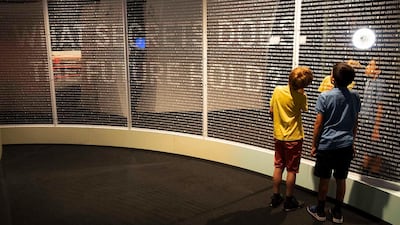Britain's Government Communications Headquarters, better known as GCHQ, is giving visitors to London's Science Museum unprecedented access to its secret operations in a new show to mark 100 years since the spy agency began its intelligence gathering. The free exhibition displays dozens of objects never before seen by the public.
Top Secret: From Ciphers To Cybersecurity explores communications intelligence and cyber security over the course of a century. The show has been designed to grab the attention of young people to encourage the next generation to consider a career with Britain's intelligence agencies. GCHQ is expanding its National Cyber Security Centre and is opening a base in Manchester next year.
Jeremy Fleming, director of GCHQ says: "For the first time the public will be given a glimpse into our secret history of amazing intelligence, world-leading innovation, and most of all brilliant people. And – as the threats to the UK become more diverse and more complex – it's a chance to encourage the next generation of recruits. Because at GCHQ we believe that with the mix of the right minds anything is possible."
The artefacts on show are around 10 to 15 per cent of what is stored in GCHQ's museum inside its base in Cheltenham, England, which can only be viewed by people with top security clearance. As expected, the exhibition does not include the latest technology in eavesdropping equipment, which is highly sensitive. However, there are some highly interesting things to look out for:
Encryption machines: On display is an early enigma machine, which was bought in 1926 in Berlin by Edward Travis, deputy head of what was then known as the Government Code and Cypher School. The German-invented machine was used by the Nazis during the Second World War to send encrypted messages. Enigma messages were routinely broken by British codebreakers, including Alan Turing, at Bletchley Park, a mansion estate in Buckinghamshire used by the intelligence service during wartime.
Exhibition-goers will also discover the Lorenz cipher machine, another encryption device used by the German Army. Mistakes made by a German radio operator using the machine helped codebreakers at Bletchley Park break the Enigma code and help the Allies win the war.
Secure telephones: During the Second World War, British prime minister Winston Churchill used the Secraphone to communicate within the government and the military service. The phone came with a large external box, named the "privacy unit", containing electronic circuits built using vacuum tubes to scramble outgoing calls and unscramble incoming ones.
By the time of the Cold War, technology had advanced, and instead the Pickwick telephone was used to keep communication secure between British prime minister Harold Macmillan and US President John F Kennedy during the Cuban Missile Crisis. A separate cipher unit scrambled the speech so it could not be understood by eavesdroppers.
In the 1980s, then prime minister Margaret Thatcher used a briefcase telephone to communicate the course of action during the Falklands War to the Defence Ministry while she was away from her desk. The "BID Brahms 470" secure telephone was used by Thatcher to inform the ministry that she was changing the rules of military engagement, which sanctioned the sinking of Argentinian ship General Belgrano in 1982.

Edward Snowden's secrets: The remains of a hard drive belonging to a Guardian journalist are featured in the show. The hard drive contained leaked documents from the National Security Agency, which were given to the newspaper in 2013 by whistleblower Edward Snowden. The hard drive was destroyed by editors at the Guardian, watched over by GCHQ officers, on national security grounds.
Spy stories: Alongside the numerous artefacts from 100 years of intelligence gathering are personal accounts spies working for GCHQ.
One, Fiona, tells of how she was deployed to Afghanistan where she passed on information about the location of roadside bombs, which saved lives.
Another agent, Jane, who worked as head of compliance in the counter-terrorism department, tells of how the 7/7 bombings on London's transport network in 2005 changed the course of her career. While Amo, a senior South Asia linguist, tells of how he left a job in sales to work for the spy agency on combating human trafficking.
The Science Museum’s Head of Collections and Principal Curator Tilly Blyth told the BBC: “These are very emotive stories that tell you about these ordinary lives where people are doing extraordinary things every day.”
Top Secret: From Ciphers To Cybersecurity is at the Science Museum in London until February 23, 2020













